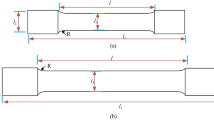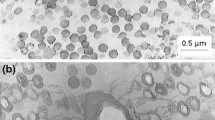Abstract
The deformation behaviour of heterogeneous tensile bars is investigated by using the recently developed multi-level finite element method (MLFEM) that allows for a numerical coupling between the microscopic and macroscopic stress-strain behaviour, combined with an accurate elasto-viscoplastic constitutive model (single-mode compressible Leonov model) and a detailed finite element model of the microstructure. The method is used to predict the influence of the microstructure on localisation phenomena in plane strain notched and hour-glass-shaped polycarbonate and polystyrene tensile specimen with different volume fractions of non-adhering or adhering rubbery particles. In Part I and II of this series it was already suggested that elimination of the unstable post-yield strain softening behaviour of a polymeric material by appropriate microstructural modifications may be essential for toughening. The results of the multi-level analyses presented in this paper confirm this statement. It is shown that a stable post-yield response, resulting from microstructural adaptations, is indeed a prerequisite for the distribution of plastic strains over the whole macro- and microstructure: massive shearing is promoted by the introduction of voids in the polycarbonate or load bearing pre-cavitated rubbery particles in the polystyrene. Furthermore, it is shown that the voids indeed reduce the macroscopic dilative stresses to safe values. The results suggest that localisations of strain and stress will always occur on a macro and/or micro level. Catastrophic failure, however, can be postponed by stabilisation of the post-yield behaviour of the material and reduction of the macroscopic dilative stresses through appropriate microstructural adjustments.
Similar content being viewed by others
References
R. J. M. Smit, W. A. M. Brekelmans and H. E. H. Meijer, J. Mater. Sci. 35 (2000) 2855.
W. A. M. Brekelmans and H. E. H. Meijer Idem., Comput. Methods Appl. Mech. Engrg. 155 (1998) 181.
W. A. M. Brekelmans and H. E. H. Meijer Idem., J. Mech. Phys. Solids 47 (1999) 201.
W. A. M. Brekelmans and H. E. H. Meijer Idem., J. Mater. Sci. 35 (2000) 2869.
E. J. Kramer, in Adv. in Polymer Sci., Vol. 52/53, edited by H. H. Kausch (Springer-Verlag, Berlin, 1983) Ch. 1.
S. Havriliak, C. A. Cruz and S. E. Slavin, Polym. Eng. Sci. 36 (1996) 2327.
M. H. Wagner and J. Schaeffer, J. Rheol. 36 (1992) 1.
D. Brokken, W. A. M. Brekelmans and F. P. T. Baaijens, J. Mater. Proc. Techn. 83 (1998) 192.
Author information
Authors and Affiliations
Rights and permissions
About this article
Cite this article
Smit, R.J.M., Brekelmans, W.A.M. & Meijer, H.E.H. Predictive modelling of the properties and toughness of polymeric materials Part III Simultaneous prediction of micro- and macrostructural deformation of rubber-modified polymers. Journal of Materials Science 35, 2881–2892 (2000). https://doi.org/10.1023/A:1004715707138
Issue Date:
DOI: https://doi.org/10.1023/A:1004715707138




